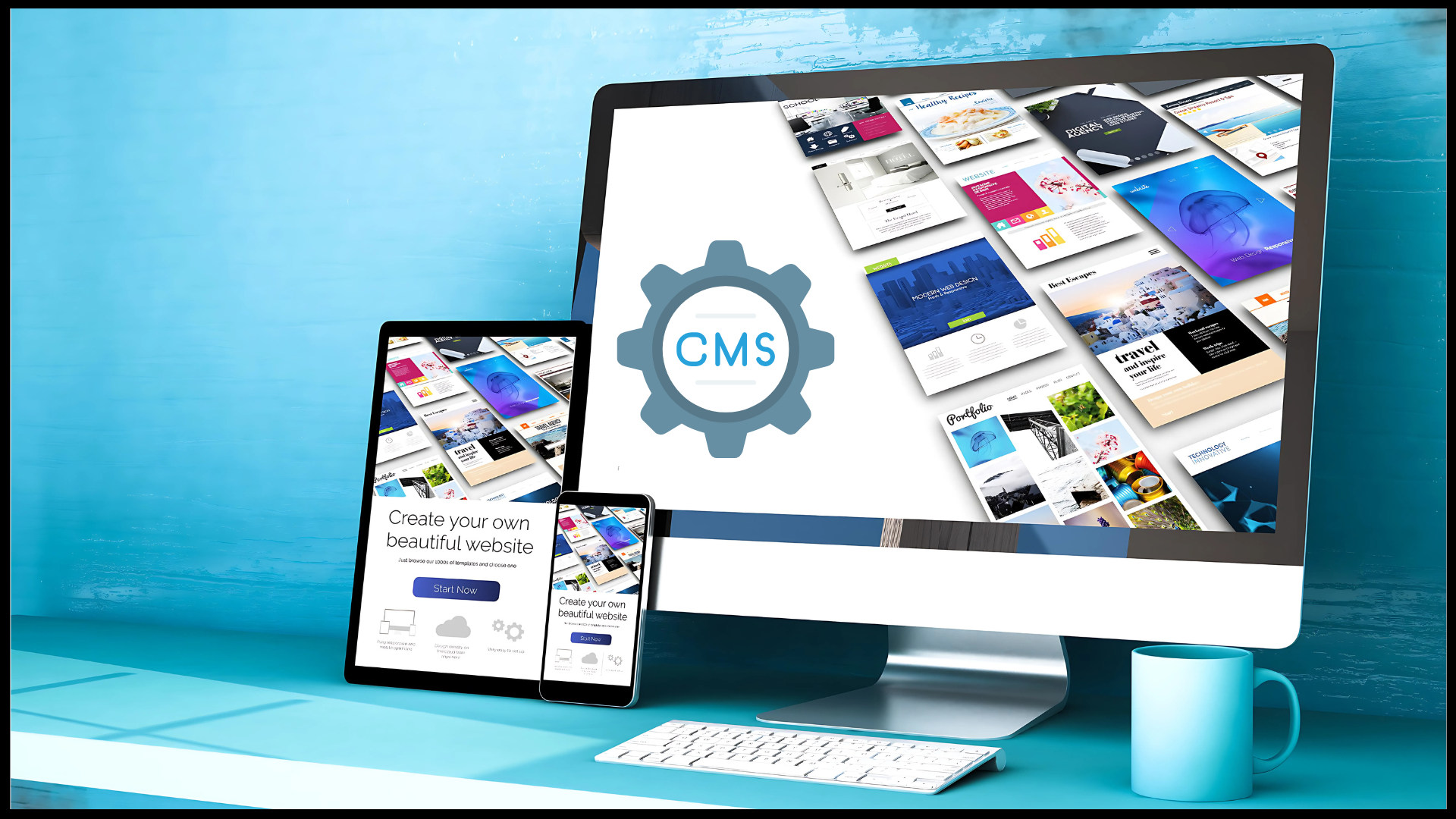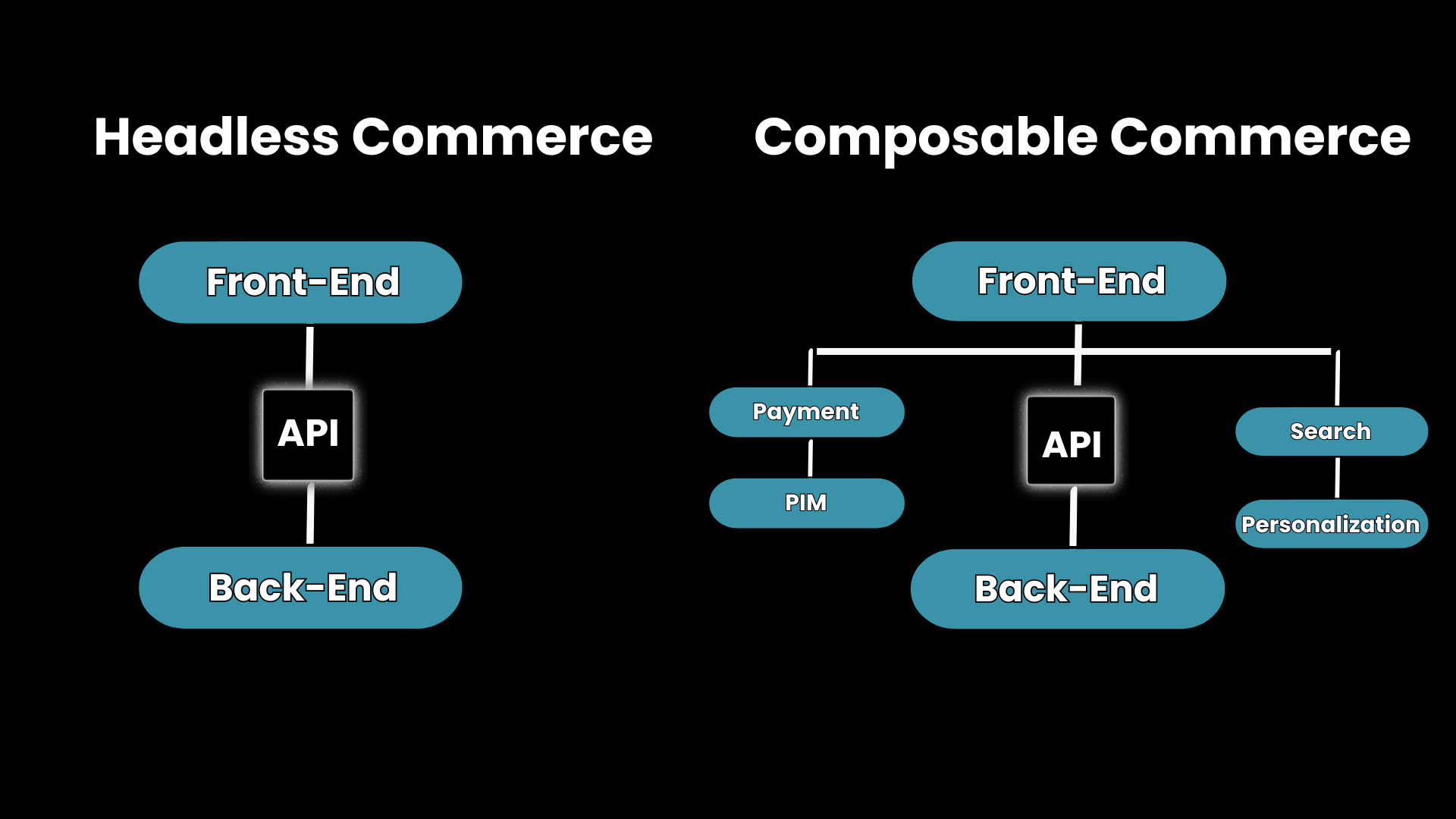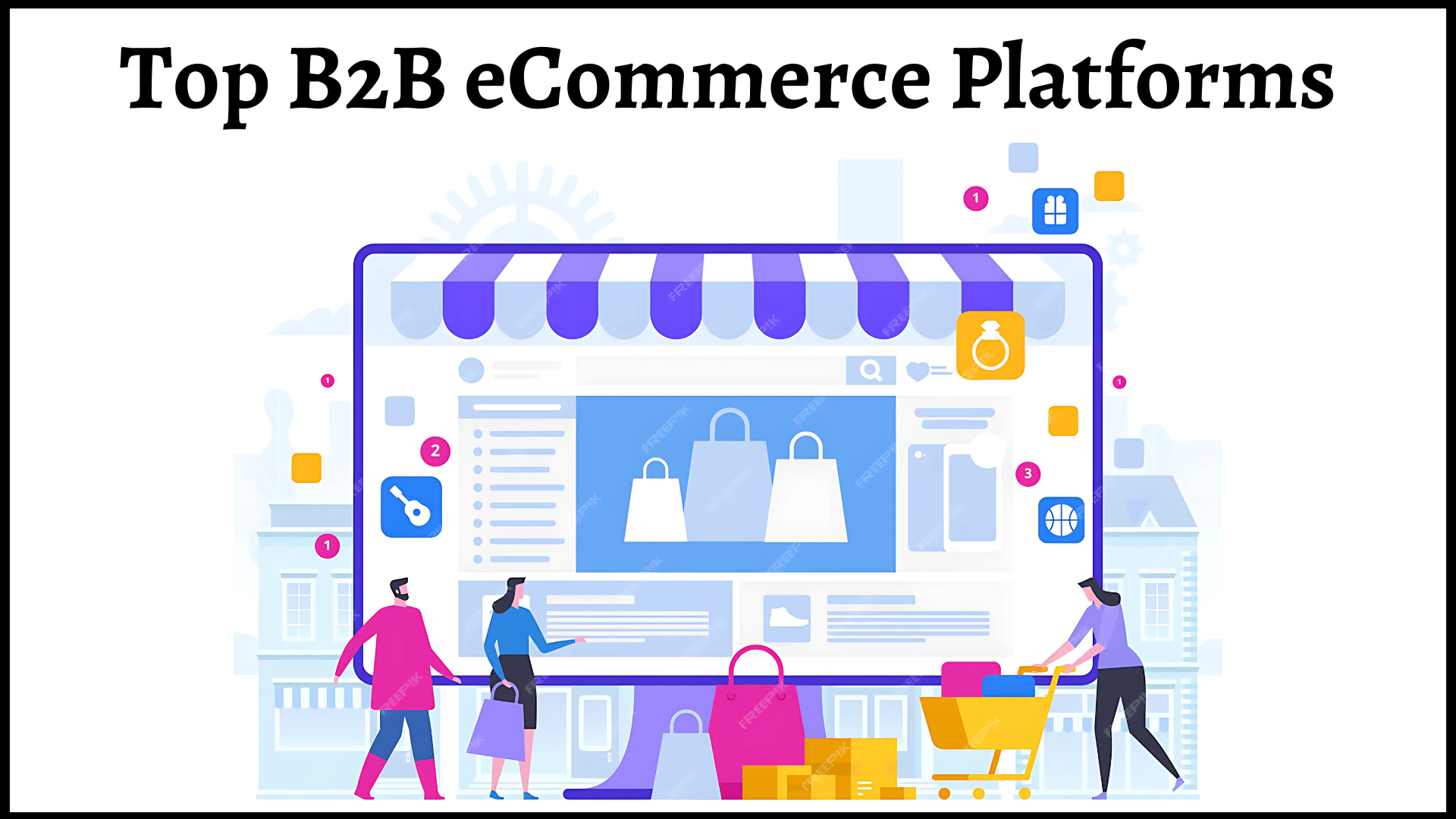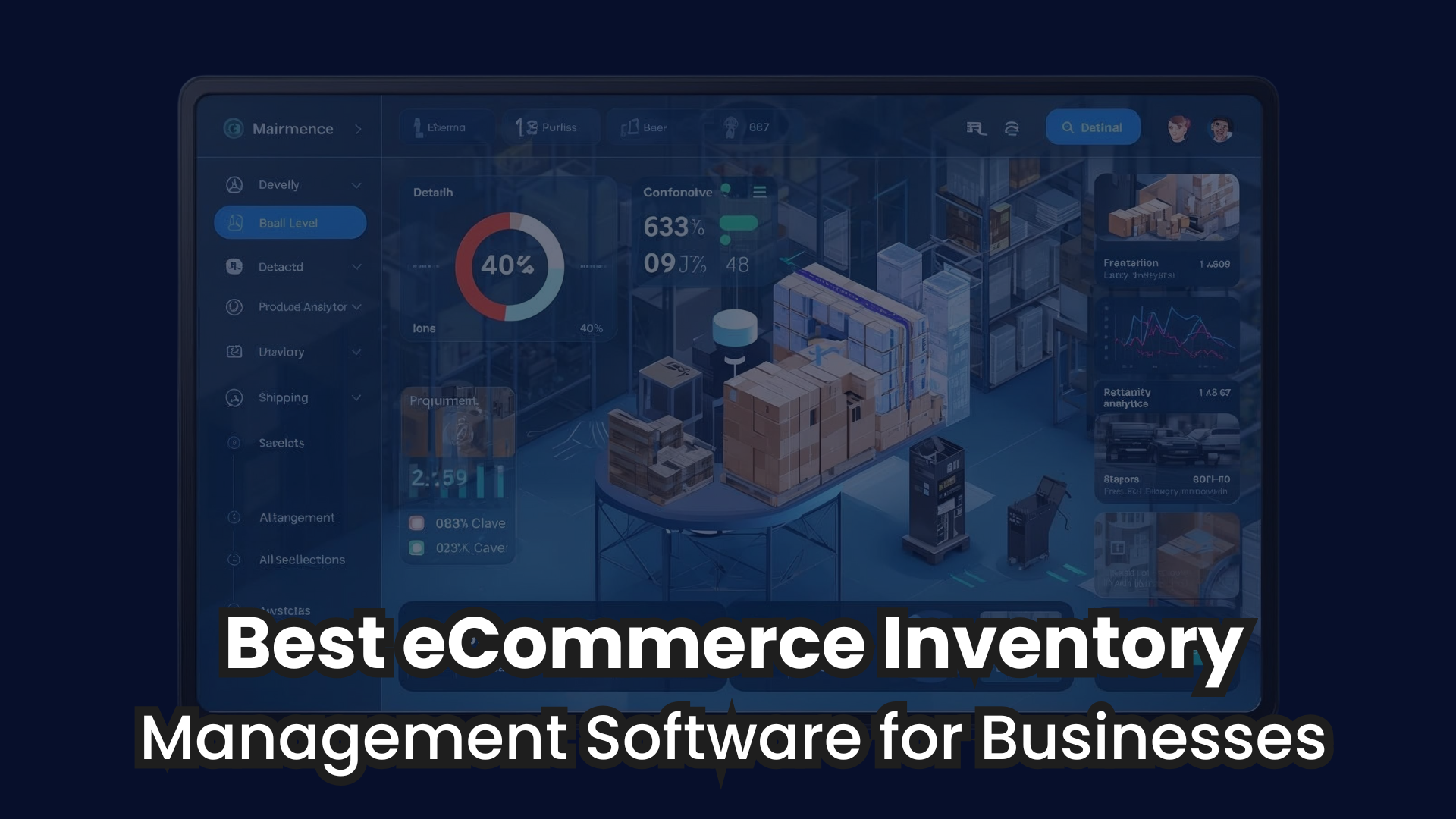- What is a CMS Migration?
- How Does CMS to CMS Migration Boost a Website’s Performance?
- Does CMS to CMS Migration Improve SEO?
- Strategic CMS Migration Planning
- How to Choose the CMS for Your Website?
- How We Build and Implement a Performance-First CMS Migration Plan?
- Why Choose CSSChopper For CMS to CMS Migration Projects?
The performance of your website either makes or breaks your online presence. Users today expect a fast-loading site with seamless navigation and security, expectations that an outdated CMS may fail to meet. If your website is underperforming, it’s time to perform a strategic CMS to CMS migration to a robust platform.
A website-focused organization must migrate from one CMS to another to maintain an effective and sustainable web presence. However, the CMS-to-CMS migration is a complex process that demands careful execution. Reports state that only 17% of data migration projects have succeeded.
Any misstep during this can put you among the 83% of migration failures. As an entrepreneur, this could be frustrating and potentially damaging to your brand. This is where our strategic CMS migration service can help you leverage the benefits of migration. We formulate a step-by-step process that translates your project needs.
This blog sheds light on the importance of CMS migration, benefits, the best-fit CMS, and the process we undergo.
What is a CMS Migration?
This process involves transferring a website’s content, data, design, and functionality from one Content Management System (CMS) to another. This process comprehensively assesses website elements, including URLs, metadata, images, and more. The subtle nuance lies in preserving and improving the site’s SEO, user experience, and overall functionality.
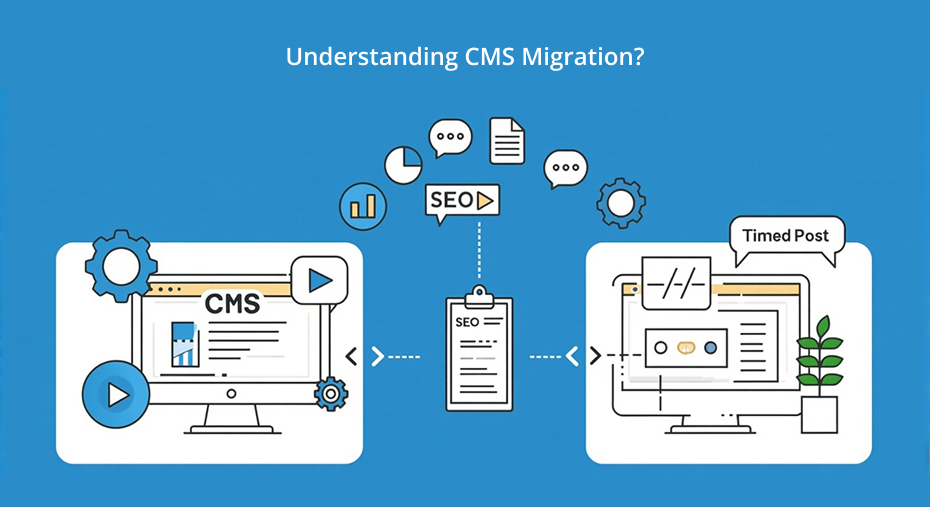
Example:
IKEA is a known example of applying digital transformation by transitioning from its old content management system to a more scalable and secure CMS. It has migrated to SAP S/4HANA to unite its disintegrated data systems and improve data-backed decision-making to manage its global eCommerce operations.
Tabular Overview of CMS to CMS Migration
Every business has its presence on diverse CMS and wants to improve its presence further by tapping into the best options. A brief on which platform would work best for your project is better to be understood before the CMS to CMS migration. Here is a tabular representation of this in the context of businesses:
| From CMS | To CMS | Why Perform CMS Migration? | Example |
| WordPress | Webflow | To achieve a cleaner design control, reduce plugin dependency, and improve site speed. | SaaS Landing Pages, Design-focused Startup |
| Drupal | WordPress | To simplify content management and make site management more user-friendly. | Content-heavy websites |
| Shopify | WooCommerce | For deeper customizability, hosting control, and lower long-term costs | Growing eCommerce businesses, niche product stores |
| Magento | Shopify | For simplifying store management and minimizing development overhead | Ideal for small to mid-size retailers |
| Joomla | WordPress | For better community support, plugins, and ease of use | Ideal for either local businesses or blog-specific sites |
Why CMS Migration is Needed?
Legacy CMS’s can bring up various challenges for their users, like slow loading, negative UX, high cost of maintenance, and more. Considering them, a business must migrate from one CMS to another and leverage the benefits, such as:
1. Faster Load Times
Over time, some CMS load times can substantially hinder its change. A website loading slowly can legitimately increase bounce rates, resulting in a loss of opportunities. Migrating to a new CMS solution often helps you overcome this hindrance. The optimized code, better caching mechanisms, and improved feature performance are the subtle reasons behind this advantage.
2. Better Security
The security of your website is also one of the potent reasons behind the “WHY” of CMS content migration. Over time, older CMSs may not receive timely security updates or patches, leaving them vulnerable to cyberattacks. Migrating to a more secure CMS ensures you get the advantage of the latest security features, regular updates, and compliance with industry standards, making the platform more robust to protect your data.
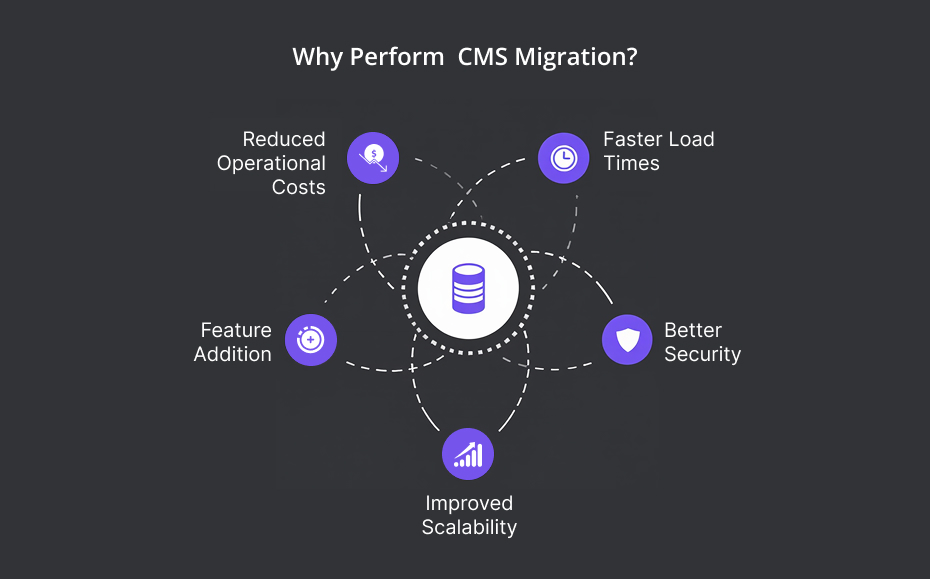
3. Improved Scalability
Legacy systems struggle to offer maximum flexibility and scalability. Migrating to a new CMS platform helps match the increasing pace by adapting to growth without compromising performance. This flexibility is one of the benefits of CMS integration, which helps expand your web presence.
4. Feature Addition
Older CMSs have fewer features, making them less suited to building a modern web presence. In this era, a new-age presence matters the most, and CMS-to-CMS migration adds value. With more advanced features, you will upgrade your site’s ability to stay competitive.
5. Reduced Operational Costs
Although the initial investment in a new CMS may be higher, the long-term savings can be significant. A more efficient CMS solution will help reduce the time and resources required for content management, streamline workflow, and lower maintenance costs. When you migrate to your preferred CMS, you can optimize your operations by allocating resources more effectively.
How Does CMS to CMS Migration Boost a Website’s Performance?
If done effectively, a content management system migrated to another can drive tangible benefits to a business. The CMS web development process can be transformative for a website, leading to significant performance and improvements in user experience. Here is how it aids:
1. Optimizing Page Load Times
New content management systems are designed to consider the value of performance. They have built-in caching strategies and optimized code, which improve the loading speed of every website page and translate to better performance. The faster the website loads, the longer users stay, leading to better engagement, user experience, and higher search rankings. This way, CMS to CMS migration directly boosts site performance and user retention.
2. Streamlining Workforce
When you migrate to a new CMS, you help streamline the workflow by improving collaboration among team members. Top CMS platforms today have user-friendly interfaces, intuitive content-related (editing) tools, and role management features. As a result, businesses can allocate resources more strategically with a clear focus.
3. Intuitive Design
CMS migration to a new version or platform would support responsive and intuitive designs, improving the user experience. Today’s platforms have customizable themes and templates optimized for different screen sizes. This also improves a website’s usability, increasing engagement and conversions.
Does CMS to CMS Migration Improve SEO?
Yes. Migrating from one content management system to another can improve SEO. The new CMS can address specific areas that improve user experience and search engine visibility. Here’s how the CMS2CMS migration to another platform drives a boost in improving SEO:
1. Improves Mobile Friendliness
Google prioritizes ranking mobile-friendly websites; over 50% of traffic comes from mobile devices. CMS offering mobile optimization features or responsive design capabilities can improve the user experience on any screen size.
2. Faster Page Load Times
The loading speed of a page is a crucial ranking factor for SEO. A content management system that optimizes loading times can minimize bounce rates and positively improve user engagement.
3. Structured Data
Migration to a CMS that supports schema markup (structured data) can help search engine crawlers better understand your site’s content, leading to rich snippets, like FAQs or product details in search results.
4. Intuitive Navigation
An intuitive navigation structure improves the user journey by making it easier for site visitors to find the relevant information more quickly. This reduces bounce rates by letting users stay on a site longer.
5. Better SEO Features
Migration to a modern CMS platform often has built-in SEO tools or plugins that facilitate on-page optimization, like meta tags, alt text, XML sitemaps, or more. These features ensure a search engine-optimized site.
6. Multilingual Support
If your new CMS offers better multilingual capabilities, it can help you reach a broader audience. Properly implemented multilingual SEO can improve visibility in different regions and languages, attracting more organic traffic.
Strategic CMS Migration Planning
Relying on outdated systems can limit your growth, and updating them in time is crucial. A well-planned CMS-to-CMS migration can help overcome these challenges with a strategic approach.
Step 1 – Define Your Business Goals
The first thing to do before delving deeper into the technicalities is to define the goals of your business. You must clarify the “WHY” you need CMS migration.
- Are you aiming for a better user experience?
- Is slow performance the central issue?
- Do you require more flexibility?
Also, whether you require a headless CMS with top-notch features or a composable CMS with a best-of-breed tech stack powered by APIs. To make informed decisions, you must align the CMS migration with your business objectives.
Step 2 – Evaluate Your Current CMS Performance
Monitor closely the performance of your current content management system and find out the pros and cons. Here is what you can do:
- Is it meeting your current business objectives?
- Are there any growth limitations related to performance, scalability, or flexibility?
- How easy is it to manage, edit, and update content?
Assessments like these will help you determine whether it’s the right time for CMS migration.
Step 3 – Identify Migration Risks
Every migration process is equipped with subsequent challenges. You must consider the risks related to the CMS to CMS migration and strategize them throughout the process, including:
- Data Loss
- Design-related Issues
- Negative Impact on SEO
- Functionality Loss
- Integration Issues
These risks are sought out if you plan according to your business requirements. Also, ensure that your CMS migration process is aligned with your business needs and is executed with minimal disruptions.
Step 4 – Full Site Audit
Before preparing a plan to migrate your CMS to another, you can perform a full site audit and backup either the whole site or the essential things you require. This can be a complex process, and it is apt to work with a proficient team. Here are the key areas they will audit:
- Page load times
- Core Web Vitals
- Plugin and theme performance
- URL structures
- Server response time
- Database structure
Auditing your site’s technical performance is mandatory. However, they also evaluate content structure, user flow, and backend usability, impacting performance.
Step 5- Define Performance Goals
Based on their audit process, the service provider will work with you to define the performance goals for your new CMS. For instance, if you require WordPress upgradation or migration to another platform, they can aid you as follows:
- Identifying and eliminating performance bottlenecks
- Set and achieve measurable goals, like reducing bounce rates
- Streamline content structure
- Building a stress-free navigation
- Ensures SEO continuity
An expert team will link these goals to your business outcomes, like SEO rankings, lead generation, or mobile-responsive site development.
Why Strategic CMS Migration Planning Matters?
A strategy built by considering the requirements of a project, budget, and specific business-related things can significantly improve the presence of a business. Similarly, the strategic CMS to CMS migration process ensures a smooth and successful transition. Here is how this process aids in reducing disruptions:
1. Minimizes Downtime
A well-planned CMS migration checklist reduces the likelihood of prolonged website outages. This ensures minimal disruption to users and business operations.
2. Preserves SEO Value
A strategic CMS migration plan includes steps to help maintain your search visibility, including 301 redirects, post CMS migration SEO optimization, and content and URL mapping.
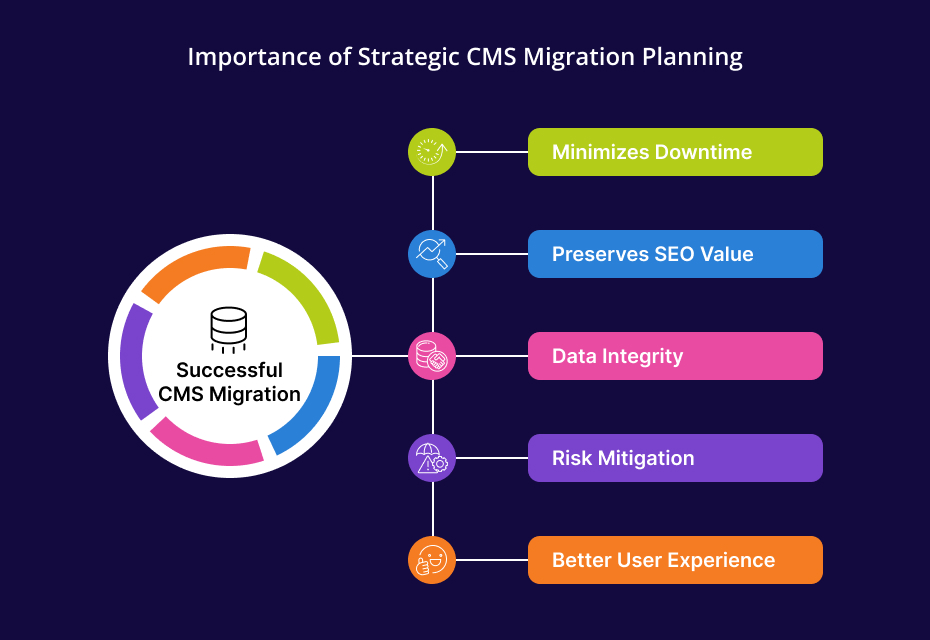
3. Data Integrity and Accuracy
A clear content migration plan ensures that all data, content, and media are accurately transferred to the new CMS, preventing data loss and corruption while maintaining GDPR compliance throughout the CMS migration process.
4. Risk Mitigation
With a strategically curated CMS migration checklist, you can identify and proactively mitigate potential risks and challenges early on, such as broken links, design inconsistency, or issues with third-party integration, ensuring a smoother transition.
5. Better User Experience
A well-executed CMS to CMS migration plan can lead to a seamless, conversion-optimized digital experience that improves overall user engagement.
How to Choose the CMS for Your Website?
You must pick the content management system for your website that delivers better performance, has built-in SEO features, strong security measures, and more. Here is a detailed understanding of the factors to consider while picking a website content migration plan:
1. Check on Performance
You must look for a CMS that prioritizes speed and performance. Check the caching techniques and tools it uses to improve your site’s loading speed.
2. Assess SEO-friendliness
Carefully review the CMS platform to assess whether it has built-in SEO tools, like meta tags, alt text, XML sitemaps, and more.
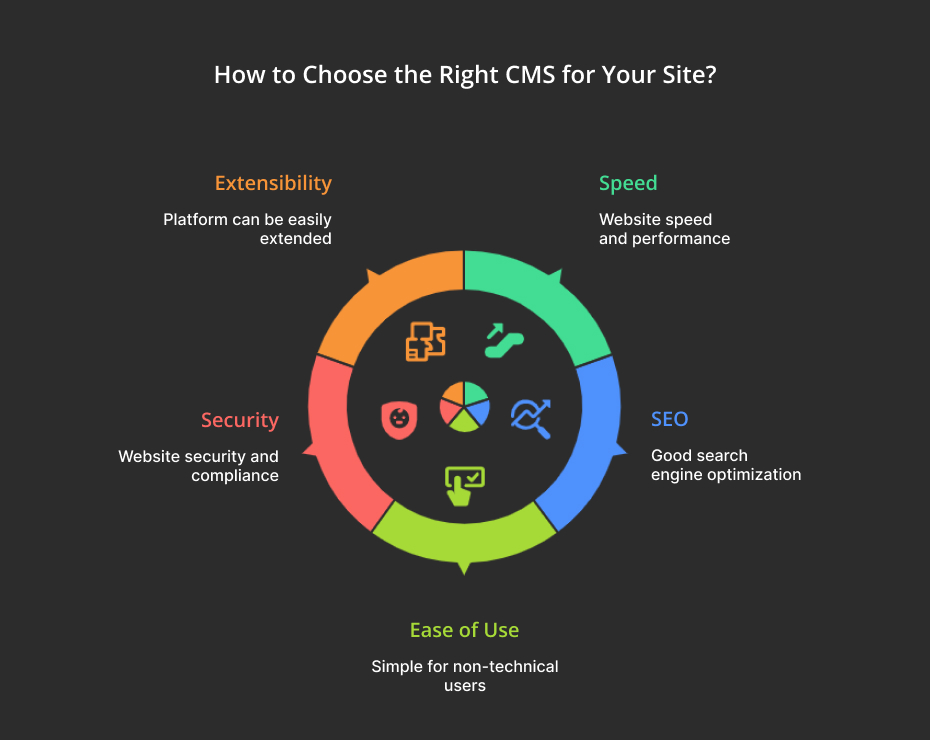
3. Analyze Ease of Use
Consider picking a CMS that is easier to use, like a WYSIWYG editor, which allows a business to simplify content curation.
4. Consider Security
You must consider that the content management system you opt for must have robust security features, timely updates, and a track record of addressing vulnerabilities.
5. Excellent Extensibility
Look for CMS platforms with a wide range of plugins and APIs that can extend functionality and integrate with other tools.
When to Choose Which CMS?
Not every CMS is built for every business type. Choosing the content management system for your project depends on certain factors, like your web development team’s technical skills, budget, ease of use, project needs, and much more. Here’s a quick tabular representation to help you find the best CMS to migrate your entire web solution based on your business type.
| Business Type | Recommended Solutions for CMS Migration | CMS to CMS Migration Reason |
| Small Businesses & Local Service Providers | Wix or Squarespace | Drag and drop website builders, built-in hosting, and quick website setup. |
| Startup & SaaS Companies | Webflow | No-code editor, quick loading pages, flexible design control, and excellent performance. |
| eCommerce Businesses (SMBs) | Shopify | Fast, secure, and comes with built-in plugins, in-built hosting |
| Growing eCommerce Businesses | WooCommerce, or Magento | Offers more flexibility, custom features, better site control, and control over hosting. |
| Enterprise Grade or Content Heavy Websites | WordPress | Offers vast plugins, themes, and templates, ease in custom development, and SEO-friendly structure. |
How We Build and Implement a Performance-First CMS Migration Plan?
CMS to CMS migration is not just entirely related to changing one platform to another, but it is more about unlocking a faster, secure, and scalable digital presence. A poorly curated plan can create CMS migration problems and hamper your end goal, which is performance. Here is how we build a performance-first strategy for your business:
1. Picking the Right CMS For Migration
We help you pick the content management system that suits your performance goals. Depending on your requirements, our experts will assist you in choosing the CMS, like:
| Need | Best CMS Options |
| Fast, static-like delivery | Webflow |
| Flexible and highly scalable | WordPress |
| High volume content | Drupal |
| eCommerce-related requirements | Shopify, Adobe Commerce, WooCommerce, or PrestaShop |
If performance, personalization, security, and speed are critical for your business, we suggest a headless content management system.
2. Content Mapping
A CMS migration strategy focusing on the performance-first approach not only moves the content but also cleans, reorganizes, and optimizes it. Here are the steps we follow:
- Remove outdated media and files
- Compress images
- Restructure headings (if required)
- Minify CSS and JS during theme reworking
We aid you with any CMS content mapping and data restructuring. We follow a strategic approach from Drupal to Joomla migration by keeping data intact.
3. Theme Setup
After working on mapping your content and restructuring it, we follow a precision-first theme setup that prioritizes screen independence. As a skilled website development service provider, we follow best practices, like:
- Avoiding bloated multipurpose themes
- Remove unused JS and CSS
- Enable lazy loading for images/videos
- Test responsiveness
This way, we build a theme that works aptly on any screen size without losing its original form.
4. Post-Migration Performance Testing
Before your new site goes live, we test your site rigorously to find whether any error is left. Our quality-first team utilizes tools like Google PageSpeed Insights, Lighthouse, GTmetrix, WebPage Test, and more.
We also check the metrics of your newly migrated site by identifying key performance indicators that matter:
- Number of HTTP requests
- Total page size
- CDN effectiveness
- Time to First Byte (TTFB) to check the server’s responsiveness
Our goal is not just to simply perform a CMS to CMS migration and launch your site, but to launch it performing at its absolute best.
5. Ongoing Optimization and Support
Our job is not completed even after your site goes live; we will monitor your site closely and make the required changes. Our agile team monitors your site continuously, and if we find a glitch, we make iterative changes (quickly). We also consider user experience and SEO enhancements to enable your migrated CMS-supported site’s visibility in the search engines.
Why Choose CSSChopper For CMS to CMS Migration Projects?
Choosing your project-specific team to complete the CMS migration process is as essential as picking the CMS type for your project. At CSSChopper, we follow a meticulous approach to migrating or upgrading your existing CMS to a new one. Our proficient team can effectively serve your business needs, whether platform-to-platform, traditional-to-headless, hybrid, or on-premise-to-cloud.
We initiate the CMS migration plan with a strategy-first approach that considers scalability, performance, speed, and responsiveness. Our decade-old experience brings deep technical expertise across platforms like WordPress, Joomla, Drupal, Magento, and more. Whether Drupal development services for a version upgrade or complete WordPress migration to a headless CMS, we’ve done it with efficacy.
Our CMS to CMS migration services set us apart, and it’s all because of our prowess. This covers everything from multi-platform expertise to ongoing support, as outlined below: s:
| What We Bring? | How does it Benefit You? |
| Multi-CMS Expertise | We work across various CMS platforms to ensure you migrate to the best platform. |
| Precision-first Engineering | Our technocrats ensure that every migration project is optimized for speed with clean code by considering Core Web Vitals. |
| SEO-first Migration Process | We ensure your search rankings are reserved with structured data migration, page redirects, and SEO-friendly architecture. |
| Transparent Workflow | When you work with us, you will be involved at every stage of CMS migration, from strategy creation to theme setup. |
| Ongoing Support | Our CMS to CMS migration services providers monitor your site, fine-tune it on time, and support your migrated site to ensure it is performance-ready. |
So, whether you are migrating your CMS platforms for better performance, scalability, and control, CSSChopper is your future-ready partner. Let’s make your next digital move your smartest one by experiencing the difference of expertise.
Categories
Recent Posts
Popular Posts
- How to Choose a Reliable Offshore Development Partner?
- Transforming Web Development with HTMX’s Declarative Approach for Dynamic UIs
- Why Your Conversion Funnel Needs a Composable Commerce Solution?
- How to Outsource Web Development in 2025: Complete Guide
- What are the Top Web Development Trends for 2025?

